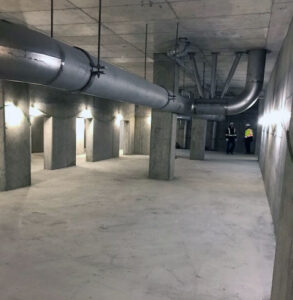 Concrete is one of the most relied-upon materials in construction, used across infrastructure, commercial buildings, and residential projects due to its strength, durability, and versatility. But despite these benefits, concrete is inherently porous, which means it’s vulnerable to water intrusion. Over time, even minor moisture exposure can lead to cracking, corrosion, and structural failure. As the most widely used man-made material on the planet, concrete demands a smarter approach to protection, one that goes beyond traditional surface treatments. That’s where crystalline and cementitious waterproofing systems come in.
Concrete is one of the most relied-upon materials in construction, used across infrastructure, commercial buildings, and residential projects due to its strength, durability, and versatility. But despite these benefits, concrete is inherently porous, which means it’s vulnerable to water intrusion. Over time, even minor moisture exposure can lead to cracking, corrosion, and structural failure. As the most widely used man-made material on the planet, concrete demands a smarter approach to protection, one that goes beyond traditional surface treatments. That’s where crystalline and cementitious waterproofing systems come in.
The Challenge of Concrete’s Porosity
At W. R. MEADOWS, we’ve been committed to concrete innovation for nearly 100 years. As part of that ongoing mission, we’ve expanded our waterproofing solutions with crystalline and polymer-modified cementitious technologies designed to extend service life and increase performance. These technologies are particularly relevant today, as the environmental costs of concrete production rise. Cement manufacturing accounts for roughly 5 – 7% of global CO₂ emissions, so extending the service life of concrete structures directly contributes to sustainability. Fewer repairs and rebuilds mean fewer emissions, less waste, and lower lifetime costs.
Crystalline & Cementitious Waterproofing Technologies
Crystalline waterproofing works differently from conventional systems. Rather than forming a surface barrier, crystalline materials are either added directly to the concrete mix or applied as a surface coating. Once introduced, they react chemically with water and un-hydrated cement particles to form insoluble crystals. These needle-like formations grow deep within the capillaries and pores of the concrete, effectively sealing pathways for water and harmful substances. The reaction is permanent and can even re-activate in the presence of future moisture, giving the concrete self-sealing properties. This internal protection guards against high hydrostatic pressure and is not easily worn away by abrasion or surface damage. As a result, crystalline waterproofing is particularly well-suited for tanks, foundations, wastewater treatment facilities, parking garages, and below-grade structures.
Polymer-modified cementitious waterproofing, meanwhile, creates a flexible, breathable barrier that bonds tightly to the concrete surface. These coatings are ideal for areas subject to movement or structural shifts, such as balconies, tunnels, or marine structures. They provide excellent crack-bridging capabilities and UV resistance, making them suitable for both above-grade and below-grade applications. Unlike some coatings that require completely cured concrete, these cementitious systems can be applied to green concrete without delamination risks, allowing for faster construction timelines and simplified workflows.
Regardless of the method used, the success of any waterproofing system depends on the integrity of the concrete itself. Mix design, material selection, and construction practices all play a vital role in performance. A poor water-to-cement ratio, improper curing, or incompatible aggregates can increase permeability, undermining even the best waterproofing efforts. That’s why understanding porosity and permeability is essential. Porosity refers to the number and size of voids within the concrete, while permeability measures how easily water moves through those voids. Higher porosity means more pathways for moisture; higher permeability means faster degradation. A well-designed mix with quality materials can significantly reduce both.
To assess the effectiveness of waterproofing technologies, industry professionals rely on permeability testing. One of the most reliable methods involves applying water pressure to concrete samples and then measuring how deeply the water has penetrated. Standards like CRD-C 48 and BS EN 12390-8 are widely used to quantify performance. In recent tests, W. R. MEADOWS’ crystalline solutions demonstrated up to 99% reduction in water permeability compared to untreated control samples. Even when tested against other market-leading products, our systems consistently deliver stronger, more reliable protection.
Ensuring Long-Term Durability: The Science Behind Waterproofing
It’s important to note that not all crystalline admixtures perform equally, even at the same dosage. That’s why performance data from standardized tests is critical when selecting a system. Some products may meet basic requirements but fall short in long-term durability or self-sealing capability. At W. R. MEADOWS, our crystalline systems are engineered to meet the two key standards outlined by the American Concrete Institute (ACI): at least 50%-90% reduction in permeability and the ability to self-seal micro-cracks for the life of the structure.
A Comprehensive Approach to Concrete Protection
While crystalline and cementitious waterproofing systems provide robust internal and external protection, they are not a one-size-fits-all solution. Construction joints, pipe penetrations, and large dynamic cracks still require additional detailing to maintain watertightness. A comprehensive waterproofing approach often involves a combination of technologies, such as membranes, sealants, drainage systems, and surface coatings, to address the full range of vulnerabilities.
Waterproofing is about more than just keeping water out, it’s about designing and building structures that last. With rising expectations for sustainability, performance, and cost-efficiency, it’s time to move beyond outdated methods and embrace smarter systems. Crystalline and cementitious waterproofing technologies are helping redefine the way we think about concrete protection, from the inside out. If you’re planning a new project or looking to extend the life of an existing structure, W. R. MEADOWS is here to help guide you to the right solution.
Request More Information
For any inquiries or to find the right solution for your project, we’re here to help. Reach out today for more details. To contact your local W. R. MEADOWS representative or for general correspondence, please click here. If you need immediate assistance, please call (800) 342-5976. Thank you!

 USA
USA Canada
Canada Français
Français International
International


